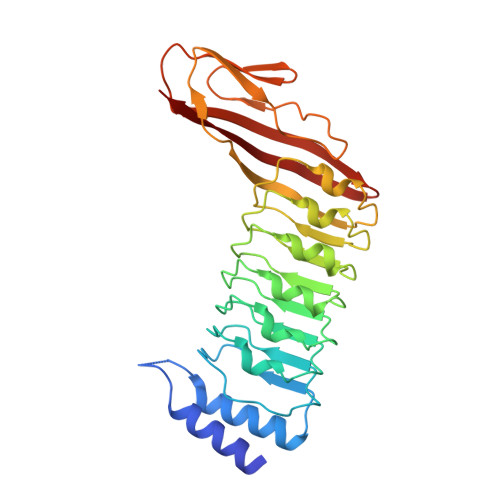Crystal Structure of an Engineered Yopm-Inlb Hybrid Protein.
Breitsprecher, D., Gherardi, E., Bleymuller, W.M., Niemann, H.H.(2014) BMC Struct Biol 14: 12
- PubMed: 24669959
- DOI: https://doi.org/10.1186/1472-6807-14-12
- Primary Citation of Related Structures:
4CIL - PubMed Abstract:
The multi-domain protein InlB (internalin B) from Listeria monocytogenes is an agonist of the human receptor tyrosine kinase MET. Only the internalin domain directly interacts with MET. The internalin domain consists of seven central leucine-rich repeats (LRRs) flanked by an N-terminal helical cap domain and a C-terminal immunoglobulin-like structure. A potential function of the N-terminal cap in receptor binding could so far not be demonstrated by deleting the cap, since the cap is also implicated in nucleating folding of the LRR domain. We generated an InlB variant (YopM-InlB) in which the InlB cap domain was replaced by the unrelated N-terminal capping structure of the LRR protein YopM from Yersinia enterocolitica. The crystal structure of the engineered protein shows that it folds properly. Because the first LRR is structurally closely linked to the cap domain, we exchanged LRR1 along with the cap domain. This resulted in unexpected structural changes extending to LRR2 and LRR3, which are deeply involved in MET binding. As a consequence, the binding of YopM-InlB to MET was substantially weaker than that of wild type InlB. The engineered protein was about one order of magnitude less active in colony scatter assays than wild type InlB. We obtained a well-behaved InlB variant with an altered N-terminal capping structure through protein design. The reduced affinity for MET precludes a straightforward interpretation of the results from cell-based assays. Still, the engineered hybrid protein induced cell scatter, suggesting that the cap is required for folding and stability of InlB but is not essential for interactions that assemble the signalling-active receptor complex. The cap swap approach described here is clearly applicable to other L. monocytogenes internalins and other LRR proteins such as YopM and may yield useful structure/function correlates within this protein family.
Organizational Affiliation:
Department of Molecular Structural Biology, Helmholtz Centre for Infection Research, 38124 Braunschweig, Germany. Hartmut.Niemann@uni-bielefeld.de.














